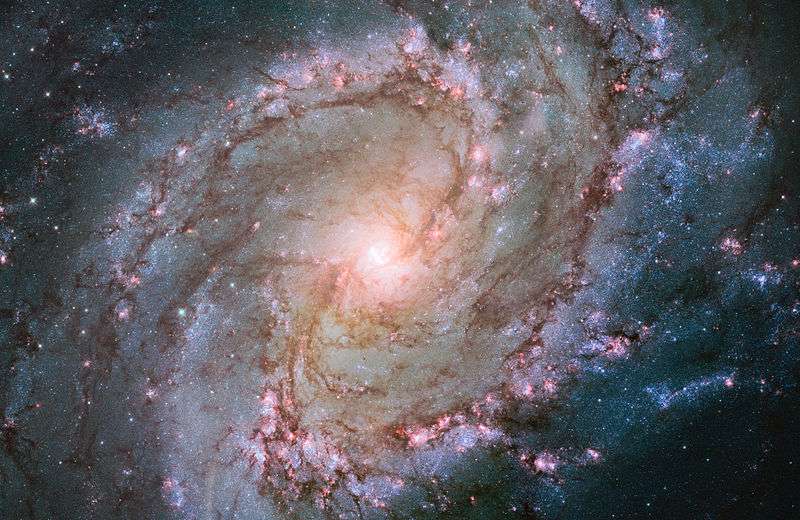Hubble view of barred spiral galaxy Messier 83. Image credit: NASA, ESA, and the Hubble Heritage Team (STScI/AURA). Credit: William Blair, Johns Hopkins University
A research group led by Erin Boettcher of the University of Wisconsin-Madison has detected and characterized an extraplanar diffuse ionized gas in the nearby galaxy Messier 83. The study, published July 25 on arXiv.org, provides important insights into kinematics of the diffuse gas in this galaxy.
Discovered in 1752, Messier 83 (M83 for short) is a barred spiral galaxy located some 15.6 million light years away from the Earth. It is one of the closest and brightest barred spiral galaxies in the sky.
M83 has a complex, multi-phase gaseous halo. The gas in such haloes is of special interest for astronomers as it is crucial to advancing knowledge about star formation. This is due to the fact that the gas necessary for continuous star formation most likely this comes from a reservoir of gas in haloes surrounding the galaxy.
Warm ionized gas with temperatures around 1,000 K is called extra-planar diffuse ionized gas (or eDIG). It is known that eDIG has different properties when compared to gas in star-forming regions. Therefore, astronomers are still searching for more evidence of this ionized gas within galaxies, which could provide more details on star formation and galaxy evolution processes.
Now, Boettcher's team reports the discovery of eDIG in M83 and describes its kinematics. The detection was made using the Robert Stobie Spectrograph on the Southern African Large Telescope (SALT), located in South Africa.
"Using optical emission-line spectroscopy from the Robert Stobie Spectrograph on the Southern African Large Telescope, we performed the first detection and kinematic study of extraplanar diffuse ionized gas in the nearby, face-on disk galaxy M83," the researchers wrote in a paper.
The astronomers revealed that the eDIG in M83 was found thanks to its emission-line ratios, velocity dispersion, and rotational velocity lag with respect to the disk.
According to the paper, the median, line-of-sight velocity dispersion observed in the diffuse gas is much higher than that observed in the Milky Way galaxy and nearby, edge-on disk galaxies. This shows that the velocity dispersions in these layers may be anisotropic.
The team noted that the diffuse emission lags the disk emission in rotational velocity, which is qualitatively consistent with the multi-phase lagging halos observed in other galaxies. The study shows that the median velocity lag between the disk and the halo exceeds the rotational velocity lags observed in several nearby, edge-on disk galaxies.
In concluding remarks, the authors suggest that if the velocity dispersion of eDIG in M83 indicates turbulent motions, there is sufficient thermal and turbulent support to produce an eDIG scale height of about 3,000 light years in dynamical equilibrium. Moreover, the researchers concluded that velocity dispersion of the eDIG layer is consistent with the sound speed in the hot phase, and rotational velocity lags are observed in both the cold and warm components.
The team plans more studies regarding kinematics of extraplanar diffuse ionized gas in various galaxies. "In future work, we will construct a sample of both face-on and edge-on galaxies, develop a picture of the three-dimensional kinematics of eDIG layers, and contextualize this picture in the multi-phase environment of the disk-halo interface," the paper reads.
More information: arxiv.org/pdf/1707.08126.pdf
© 2017 Phys.org
























